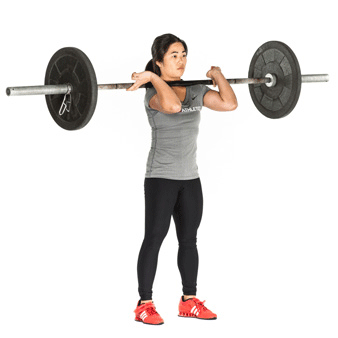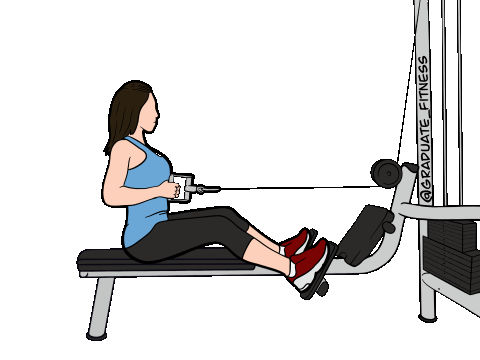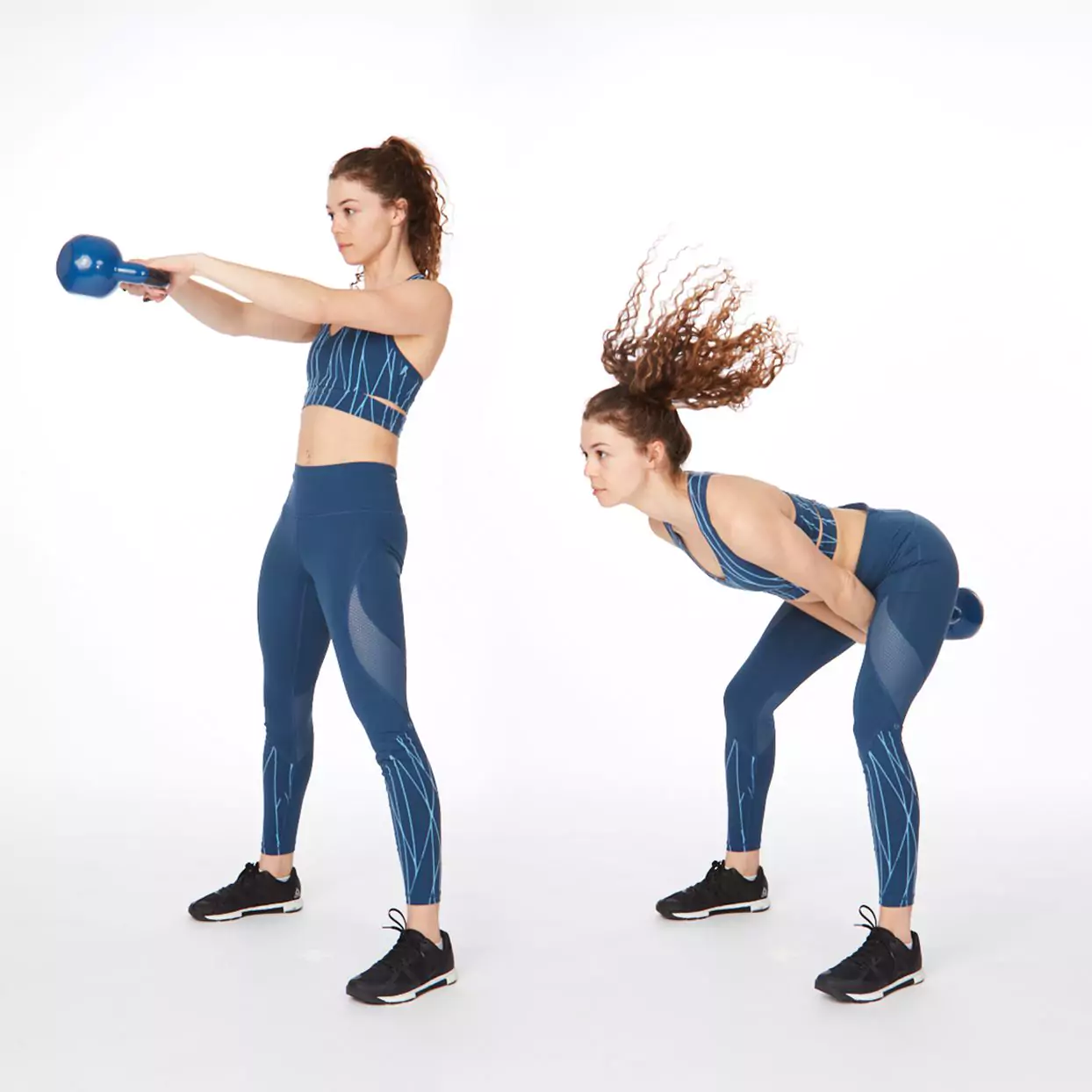When it comes to developing your lower body’s strength and power, front squat are a must. As a compound exercise, front squats target the quads, hamstrings, and glutes, helping you build a more muscular and chiseled lower body. What’s even better? To begin, you won’t need a lot of tools. Simply acquire a barbell and some weight plates, and you’re ready to begin.
A recent poll of fitness professionals found that front squats are highly regarded as an effective way to strengthen the legs and glutes. Eighty-seven percent of trainers stated they have their clients do front squats as part of their workouts. As well they should. Muscle activation in the legs might be increased by as much as 30 percent when performing front squats, according to research.
In addition to being an excellent alternative for anyone hoping to get in better shape generally, front squats are also beneficial for those who are wanting to correct poor posture and lessen the likelihood of lower back issues.
The Value of the Front Squat in Strength Training
For lower-body strength, power, and explosiveness, the front squat is essential. The front squat needs more core stability and quadriceps, hamstrings, and glutes because the barbell is in front of the body. It targets these muscles and builds lower body strength.
Front squats improve posture, strength, and injury risk. Front squats can counteract sitting and improve spinal alignment by exercising the core and fostering an upright posture. Front squats are safer for lower back pain sufferers since they put less stress on the lower back than back squats.
Front squats boost power and explosiveness, making them crucial for athletes and other sportspeople. Front squats teach the body to create force from the legs, improving speed, agility, jumping, and hopping.
Front squats are great for strength, posture, and power. Front squats can help you attain your goals and perform better, whether you’re an experienced athlete or a beginner.
Physiology of Front Squatting

Because it is a complex movement that engages numerous muscular groups at once, the front squat is an excellent approach to strengthen both the legs and the abdominal region. The front squat is an exercise that, when executed properly, can assist in activating and strengthening the following muscle groups:
Quadriceps
The massive muscles that can be found on the front of the thighs are known as the quadriceps. They are the ones who are in charge of extending the knee, and during front squats, they play a significant part in the process of raising the weight.
Hamstrings
The muscles that can be found at the back of the thighs are known as the hamstrings. During the front squat, it is their job to flex the knee and provide stability to the body.
Glutes
The muscles that are found in the buttock region are known as the glutes. During the front squat, they are the ones who are in charge of extending the hips and also play a significant part in supporting the lower back.
Core
In order to keep an upright stance and prevent the bar from tipping forward, the front squat calls for a high degree of core stability. When performing front squats, it is important to engage the rectus abdominis, obliques, and lower back muscles in order to maintain stability.
Shoulders
In order to keep control of the bar when performing front squats, you need to have strong posture and stability in your shoulders. During a front squat, the deltoid muscles, the rotator cuff muscles, and the trapezius are all engaged in the process of stabilizing the shoulders.
Front Squats vs Back Squats
Both the front squat and the back squat are excellent workouts for developing lower-body strength because they focus on the squatting motion. On the other hand, there are a number of significant distinctions between the two that give each its own individual identity.
- The placement of the bar is the primary distinction between front and back squats. The bar is held in front of the body, usually across the clavicle and the front of the shoulders, during a front squat. The bar is placed on the upper back, typically across the traps, for a back squat.
- Front squats and back squats have different demands on the body because of the location of the bar. The quadriceps, glutes, and abs benefit most from front squats, while the hamstrings, glutes, and low back are targeted most effectively by back squats.
- Due to the bar’s position in front of the body, front squats call for a higher degree of stability and control on the part of the lifter. Particularly for those who are less mobile or have bad posture, this might make front squats more difficult.
- A front squat is preferable than a back squat for people who have experienced lower back pain in the past because of the former’s less strain on the spine. However, this can be problematic for people who already have shoulder troubles because it increases the strain on their shoulders.
- As the bar is higher in the air during a front squat, stability and control are more important, hence most people execute front squats with lesser weights. Strength and muscular mass can be improved by doing any exercise with high weights.
Related: Achieve Your Dream Midsection: The 21 Must-Try Ab Exercises
Benefits of Front Squatting
Squats in front of the body are an excellent form of training that provides the body with a variety of advantages. Front squats provide a number of important health benefits, including the following:
Increased Lower Body Strength
The quadriceps, hamstrings, glutes, and core are all targeted during front squats, which makes it an ideal exercise for developing lower body strength. Front squats, especially when performed with heavy weights, can be an effective way to build muscular mass and general strength in these muscle groups.
Improved Posture
As a result of the requirement for an upright posture and a significant engagement of the core muscles, front squats can assist improve posture over time. This is especially helpful for people who have poor posture as a result of spending a lot of time sitting and who can benefit from having better posture as a result of doing this.
Reduced Risk of Injury
People who have a history of lower back pain might consider switching to front squats rather than back squats because front squats exert less stress on the lower back than back squats do. In addition, front squats can assist in bettering spinal alignment and lowering the risk of damage to the lower back area.
Increased Power and Explosiveness
Front squats are an excellent exercise for athletes and other individuals who want to improve their performance in sports or other physically demanding activities since they can assist build power and explosiveness in the legs.
Improved Balance and Stability
Squats in front of the body need a high level of balance and stability, particularly in the abdominal region. Front squats, when performed consistently over time, can help to improve general balance and stability, hence lowering the chance of injury during other types of physical activity.
Improved Flexibility
To perform front squats effectively, you need to have sufficient mobility in your hips, knees, and ankles. Front squats, when performed regularly, can assist to develop flexibility in these regions over time, which can help to lower the chance of injury and boost overall performance.
How to Perform a Front Squat
It is essential to perform a front squat in the correct manner in order to get the most out of the exercise and stay safe from injury. The following instructions will assist you in performing front squats with the appropriate form and technique:
Proper Form and Technique
Set up the barbell
To begin, position yourself so that you are facing a barbell with your feet about shoulder-width apart. Take one step forward and position the bar so that it lies over the front of your shoulders. Grasp the bar with both hands. Your hands should be spaced a little further apart than shoulder width, and your elbows should be pointed forward.
Brace your core
Before commencing the squat, you should activate your core by tightening the muscles in your abdominal region. Because of this, it will be easier to keep the correct posture and retain stability throughout the exercise.
Descend into the squat
To perform a squat, start by bending your knees and bringing your hips back behind you. As you fall, be sure that your weight is distributed evenly between your heels and your back. It is important to make sure that your knees are tracking over your toes, but you should also avoid allowing them to sink inward.
Go as low as you can
Your level of flexibility and mobility will determine how deep you can go into the squat. Your goal should be to get as low as you can while still keeping your form and control in check. Throughout the exercise, make sure that you keep your core engaged and your chest elevated.
Drive back up
Stand back up by applying pressure on the balls of your feet, then straighten your legs. When you come back up to the beginning position, be careful to keep your abdominal muscles engaged and your back in a straight position.
Repeat
Perform the movement until you have reached the appropriate number of repetitions, ensuring that you keep your form and technique correct throughout.
Related: Lat Pulldown 101: The Key to a Strong and Defined Upper Back
Avoid These Mistakes While Performing Front Squats
Rounding the lower back
This can cause unneeded strain on the lower back, which in turn increases the likelihood of injury. Maintaining an engaged core and a lifted chest during the movement can help you prevent rounding your lower back, which can cause pain and discomfort.
Allowing the knees to cave inward
This can cause an abnormal amount of stress to be placed on the knee joint, which raises the risk of damage. To prevent this from happening, you should concentrate on maintaining knee tracking over toe tracking and avoiding any inward collapse.
Using too much weight
When using an excessive amount of weight, it might be difficult to maintain proper form and technique, which in turn makes it more difficult to complete the exercise effectively. Your strength and technique will improve over time, so begin with a small weight and progressively work your way up.
Not keeping the barbell in the correct position
The barbell should be positioned so that it is across the front of the shoulders, and the grip on the bar should be somewhat wider than the distance between the shoulders. It may be challenging to keep good form and control if the barbell is placed at an incorrect height or if it is positioned too low.
Not engaging the core
The core muscles are responsible for a significant portion of the work involved in preserving correct posture and maintaining stability throughout the exercise. To prevent making this error, give your full attention to activating your core before commencing the squat.
Not using a full range of motion
To get the most out of your front squats, you need to move through your entire range of motion. Be sure to get as low as you can while still keeping your form and control in check, and don’t cheat the movement by merely going part of the way down; you want to get as low as you possibly can.
Variations of Front Squat for Different Fitness Levels
The front squat is a flexible exercise that may be modified to match the requirements of individuals who have varying degrees of fitness. The front squat can be modified in a number of ways to accommodate a wide range of fitness levels; the following are some examples:
Bodyweight Front Squat
The bodyweight front squat is an excellent exercise for people who are just beginning their fitness journey or who have limited strength. You may perform the squat without adding any additional weight to your routine by simply standing with your feet hip-width apart and your hands on your hips.
Dumbbell Front Squat
Those who have advanced beyond the bodyweight front squat and are looking for a new challenge may find that adding dumbbells to their routine is a good option. Squat down with a pair of dumbbells held at your sides as you concentrate on keeping good form and keeping in control of your movement.
Barbell Front Squat
The front barbell squat is the original form of this exercise. It is an excellent way to test your strength and stamina and is a wonderful way to build muscle. As you execute squats with the barbell positioned in front of your shoulders, your primary focus should be on ensuring that your form and technique are correct.
Goblet Front Squat
Another version that may be utilized to test your strength and endurance is the goblet front squat. You can use this exercise to challenge yourself. Squat down while controlling your form and keeping a dumbbell or kettlebell in front of your chest. Focus on maintaining the correct posture throughout the exercise.
Overhead Front Squat
The overhead front squat is an advanced form of the squat that calls for a high level of strength, mobility, and stability. Squat down while holding a barbell or a pair of dumbbells above your head. Pay attention to your technique and make sure you keep complete control throughout the exercise.
Also See: 9 Rules for a Healthy Back
Stretches Before Front Squats
To get your muscles and cardiovascular system ready for the rigours of the workout that’s about to come, it’s vital to warm up first. The following are some examples of warm-up activities that can assist you in getting ready for front squats:
Foam rolling
The front squat can be performed more easily with correct form if you use foam rolling to assist release tension and tightness in the muscles. Spend one to two minutes rolling your legs, hips, and lower back, paying particular attention to any areas that seem stiff or painful.
Dynamic stretching
When you engage in dynamic stretching, you move through a range of motion in order to help enhance your range of motion and get your muscles ready for the workout. Lunges, leg swings, and high knees are some examples of dynamic stretches that can be used in conjunction with front squats.
Bodyweight squats
Squats using only your bodyweight are an excellent technique to warm up your legs and hips, so preparing them for the demands of the front squat. Begin by performing 10-15 bodyweight squats while concentrating on maintaining correct form and maintaining control.
Light cardio
Jogging, jumping jacks, and jumping rope are all examples of light forms of cardio that can assist improve your heart rate and get your blood flowing, thereby preparing your body for the workout that is to come. Before beginning your front squat workout, you should aim to complete five to ten minutes of light cardio.
Warm-up sets
Lastly, practising warm-up sets of the front squat will help prepare your muscles and boost your body temperature, which will make it much simpler for you to complete the exercise with the correct form and under control. You should begin with a lower weight and progressively raise it for each warm-up set. This will allow you to work your way up to the weight you will be working with for the day.
Workout Routines Incorporating Front Squats
The front squat is a flexible exercise that can be included into a range of different fitness programmes due to its adaptability. The following is a list of examples of different types of workouts that include front squats:
- Strength training should include front squats. Perform 3-4 sets of 8-12 reps with a moderate to heavy weight, focusing on form and technique. For a full-body workout, combine front squats with deadlifts, lunges, and bench presses.
- A leg-and-hip workout can target your lower body. Pair front squats with Bulgarian split squats, lunges, and calf lifts for 3-4 sets of 8-12 reps.
- HIIT workouts can include front squats. For a tough, full-body workout, add jump squats, burpees, and mountain climbers.
- Front squats can be done using bodyweight alone. Perform 3-4 sets of 8-12 reps with good form in a bodyweight workout. For a full-body workout, add push-ups, pull-ups, and squats.
- Front squats can warm up your body for your workout. Using a light weight, do 1-2 sets of 8-12 repetitions with correct form.
Adding Weight to Front Squats for Progressive Strength Training
The front squat is an excellent exercise for progressing your strength training and challenging your muscles. To make this exercise more difficult, add weight to the bar. The following are some suggestions to help you add weight to your front squats:
- Start with a light weight to do the exercise correctly. Focus on form first, then add weight as you get stronger.
- Weightlifting belts support your lower back, making heavy front squats easier.
- Gradually add weight to front squats. Once you can easily do the appropriate amount of reps with proper form, add 5-10 pounds at a time.
- Focus on form and technique when doing the front squat, regardless of weight. Reduce the weight until your form improves.
- Other exercises might help you gain strength and stability together with front squats. Front squats, deadlifts, lunges, and bench presses make a full-body workout.











